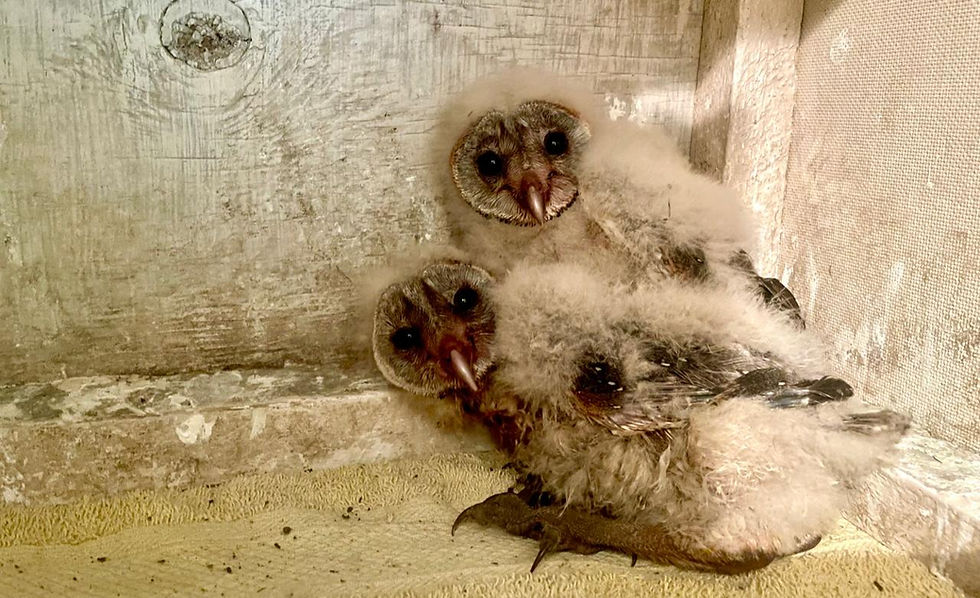The Crowned Eagle - Our Founding Raptor
- Simon Thomsett

- Sep 23, 2021
- 4 min read
Updated: Sep 24, 2021
When Rosy the male Crowned Eagle was brought into Simon's care with a broken wing in 1976 the Crowned Eagle became our founding raptor. Rosy went on to breed 9 young with "Girl" being the world's first captive breeding pair of Crowned Eagles. All their young were released and some went on to form pairs and breed in the wild.

To watch Rosy and Girl’s young find mates, build nests and have young in the wild was the greatest pleasure of my life and I owe a great deal of people, from KWS rangers, wardens and senior officers, conservancy owners, a lodge pastry cook (who built up a rapport with one of the birds for 11 years), lodge/camp owners and a very eclectic bunch of volunteers. We had fun back then and proved that we can captive breed and successfully release one of the most challenging of all raptors.
Crowned Eagles are built like giant goshawks with short wing and long tail. They are also disproportionately powerful with a massive hind talon over 10cm...making it the longest killing implement in all of Africa...even longer than a male lion's canine tooth. But it is not the fact that they are eagles, huge and menacing eagles to some, that I find fascinating, it's their biology. Their life, what they need, how they behave, the various age groups they go through, the skills they acquire through being taught by parents, their life-long devotion to their mate and how they are moulded by the school of hard knocks.
How the pair learns to survive as a team and has to stick together is what I find so interesting. It is also their vulnerability. They struggle hard to live and today the survival of just a few of their kind in Kenya depends wholly upon the sanctity of our indigenous forests and protected areas.

The vast majority of Crowned Eagles live in indigenous forests with a moderate to high density native prey species. They weigh less on average than the longer winged and taller Martial Eagle though females can be similar in weight. They are not comparable when it comes to strength and they probably kill on average larger prey than any other eagle in the world. Monkeys are certainly favoured prey in dense central and west African forest and duiker and juvenile antelope are more often taken in eastern and southern Africa. Smaller prey such as hyrax, galagos, genets, mongoose, and large birds tend to form much of their prey in human altered forests. In Durban, South Africa they have learned to adapt to urban landscapes nesting within a few hundred meters of houses and in Nairobi there are still very persistent pairs within the urbanised forests. The future of these "city" eagles depends wholly upon a very high tolerance of the people around them.
Crowned Eagle's Status on the IUCN Red List
How can we reliably estimate the population and trends of raptors when estimates differ as much as 25% to 50%? Unfortunately for many species that margin of error may make it either ‘Least Concern’ or Critically Endangered’. To try to answer status one could simplify it by examining three broad areas of concern: habitat, food, and mortality. The Crowned Eagle is a forest species with the lowest reproductive rate of all African raptors, competes with humans for “bush meat” and is persecuted over 90% of its range. This summary should be alarming. However, due to its South African status, I believe, the Crowned Eagle is officially listed as “Least Concern”. In Kenya the status is much different and I believe, with great certainty, that the conservation status of Crowned Eagles is "Vulnerable" or worse.
While assessing the habitat needs of a Crowned Eagle, there is one very important point that is often misunderstood. While you can find them nesting in very small forest patches, this does not mean such patches are sufficient for this eagles's survival and assume all is good because it is not. Obliged to retreat to a shrinking habitat, these eagles have to change their diet to suit what is available and livestock is almost all they have to choose from increasing the threat of human-wildlife conflict thus the threat to their existence.

About Rosy
Rosy was born around 1976, about a year before I met him in a small cage at the Aberdare Country Club. I was a teenager with only nine years of falconry and raptor rehab experience under my belt and Rosy was unquestionably out of my depth. Somehow we managed.
Around 1986 I got him a beautiful adult female with whom he fell in love within seconds. That was hilarious. He stood tall and goggle-eyed and when I went to pick him up he leapt at me to show her who was boss. She on the other hand gave no indication at all of any affection or interest. Poor Rosy, he had no idea how to cope with her.
Rosy did do precisely what was needed for the future of his and other wildlife species. He bred in captivity and successfully had his young go on to breed in the wild. A first for Africa.
Rosy died of a cobra bite in April 2019. His mate, Girl, now in her 5Os, lives at Soysambu Raptor Centre with her new mate George, where she may breed again one day soon.






Comments